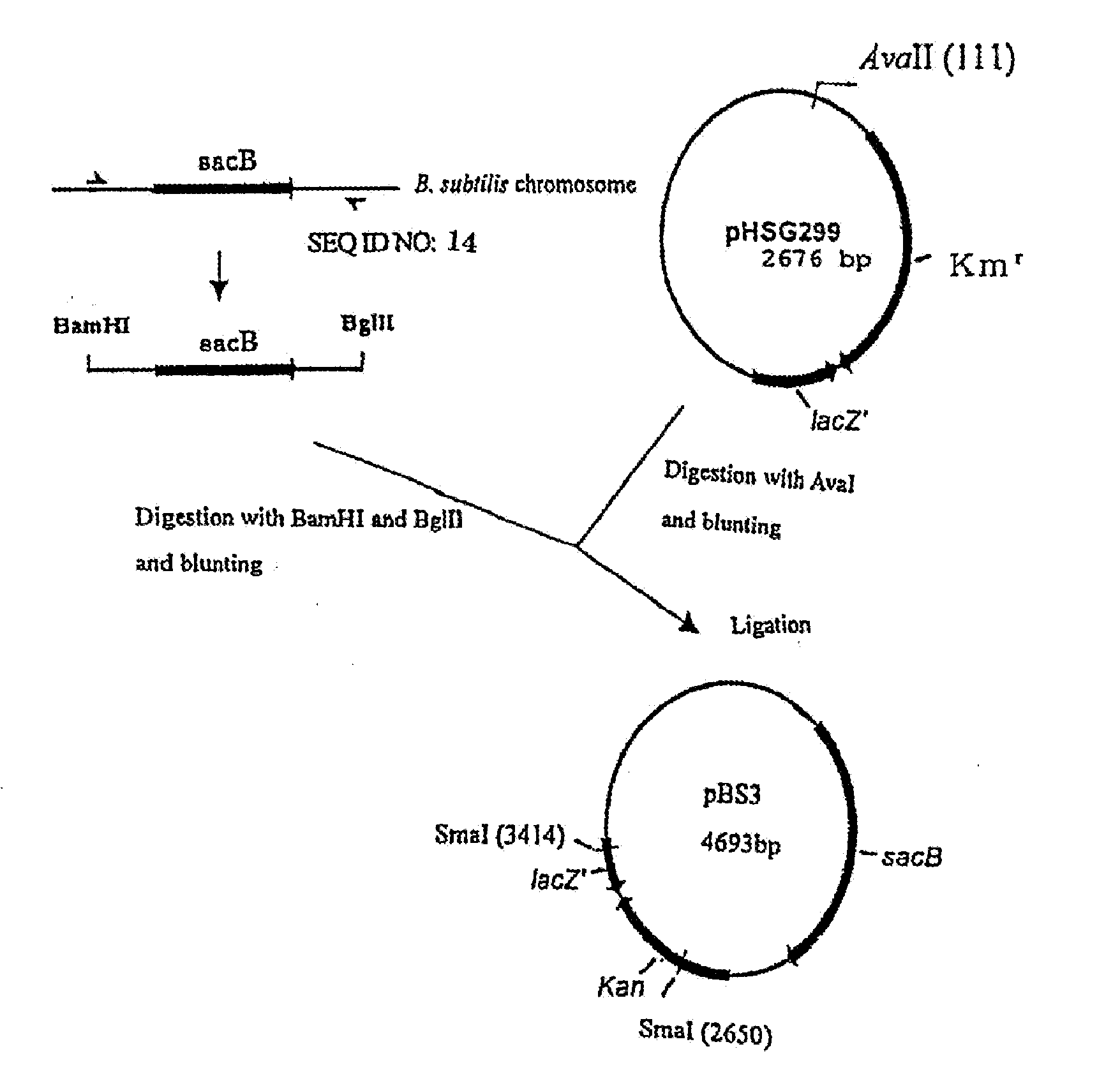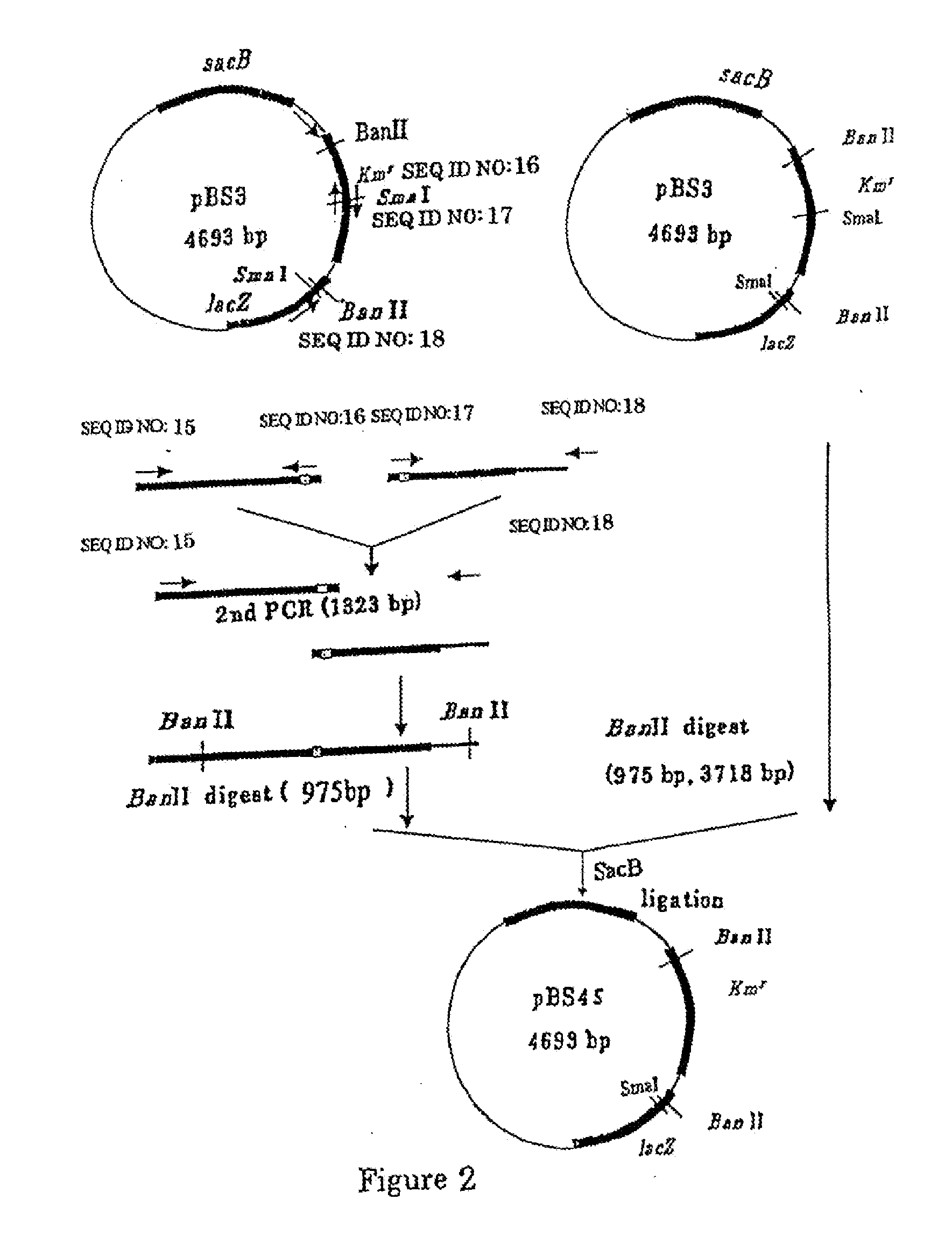L-glutamic acid-producing microorganism and a method for producing l-glutamic acid
a technology of l-glutamic acid and microorganisms, which is applied in the field of l-glutamic acid-producing microorganisms, can solve the problems of slow growth of -kgdh gene-deficient strains, decrease in fatty acid or cell wall synthesis, and difficulty in producing l-glutamic acid, so as to improve the ability of coryneform bacterium to produce l-glutamic acid. the effect o
- Summary
- Abstract
- Description
- Claims
- Application Information
AI Technical Summary
Benefits of technology
Problems solved by technology
Method used
Image
Examples
example 1
[0335]
[0336](1-1) Construction of pBS3
[0337]Construction of the gene disruption vector carrying the sacB gene was performed by using the method in WO2005 / 113745 and WO2005 / 113744. A sacB gene (SEQ ID NO: 11) was obtained by PCR using a chromosomal DNA of Bacillus subtilis as a template and oligonucleotides of SEQ ID NOS: 13 and 14 as primers. The PCR was performed using LA taq (manufactured by TaKaRa) as follows: one cycle of heat retention at 94° C. for 5 minutes; and 25 cycles of denaturing at 94° C. for 30 seconds, annealing at 49° C. for 30 seconds, and elongation at 72° C. for 2 minutes. The obtained PCR product was purified by a conventional method, and then digested with BglII and BamHI and blunt-ended. The fragment was inserted into pHSG299 which had been digested with AvaII and blunt-ended. The obtained DNA was used to transform competent cells of Escherichia coli JM109 (manufactured by TAKARA BIO INC.). Then, the transformed bacterial cells were spread on LB agar medium co...
example 2
[0341]C. glutamicum ATCC13869 Strain>
[0342]The nucleotide sequence of the odhA gene encoding the α-ketoglutarate dehydrogenase of coryneform bacterium has already been identified (Microbiology 142, 3347-3354, (1996), GenBank accession No. D84102). Based on the nucleotide sequence of the odhA gene, the primers described in SEQ ID NOS: 1 and 2 were designed, and PCR was performed using the primers and the chromosomal DNA of the ATCC13869 strain as a template to amplify the internal sequence of the odhA gene. The amplified PCR fragment was completely digested with BamHI and inserted to the BamHI site of pBS4S constructed in Example 1, thereby the plasmid pBS4SΔsucAint was obtained (FIG. 3).
[0343]pBS4SΔsucAint was introduced into C. glutamicum ATCC13869 strain by the electric pulse method (JP-A-02-207791) and the transformed bacterial cells were spread over CM-Dex agar medium (5g / l glucose, 10 g / l polypeptone, 10 g / l yeast extract, 1 g / l KH2PO4, 0.4 g / l MgSO4.7H2O, 0.01 g / l FeSO4.7H2O, ...
example 3
[0345]
[0346]In the 2A-1 strain, the odhA gene on the chromosome was disrupted by pBS4SΔsucAint. By curing the plasmid from the chromosome of this strain, the odhA gene could be reverted to the wild-type one. Although the odhA gene-disrupted strain grows very slowly in a medium containing no sugar, the odhA gene-revertant strain in which the odhA gene-revered to the wild-type one grows well in a medium containing no sugar such as CM2B (10 g / l polypeptone, 10 g / l yeast extract, 5 g / l NaCl, 10 μg / l Biotin, 20 g / l agar, adjusted to pH 7.0 with KOH). To obtain such a revertant strain, the 2A-1 strain was spread over CM2B agar medium to select growth-improved strains. The growth-improved strain which appeared was named 2A-1R and isolated on the CM2B agar medium and the kanamycin-sensitivity of the 2A-1R strain was examined. As a result, it was found that all of the selected strains were kanamycin-sensitive and sucrose-resistant. Since the pBS4SΔsucAint contains a kanamycin-resistant gene ...
PUM
 Login to View More
Login to View More Abstract
Description
Claims
Application Information
 Login to View More
Login to View More - R&D
- Intellectual Property
- Life Sciences
- Materials
- Tech Scout
- Unparalleled Data Quality
- Higher Quality Content
- 60% Fewer Hallucinations
Browse by: Latest US Patents, China's latest patents, Technical Efficacy Thesaurus, Application Domain, Technology Topic, Popular Technical Reports.
© 2025 PatSnap. All rights reserved.Legal|Privacy policy|Modern Slavery Act Transparency Statement|Sitemap|About US| Contact US: help@patsnap.com



